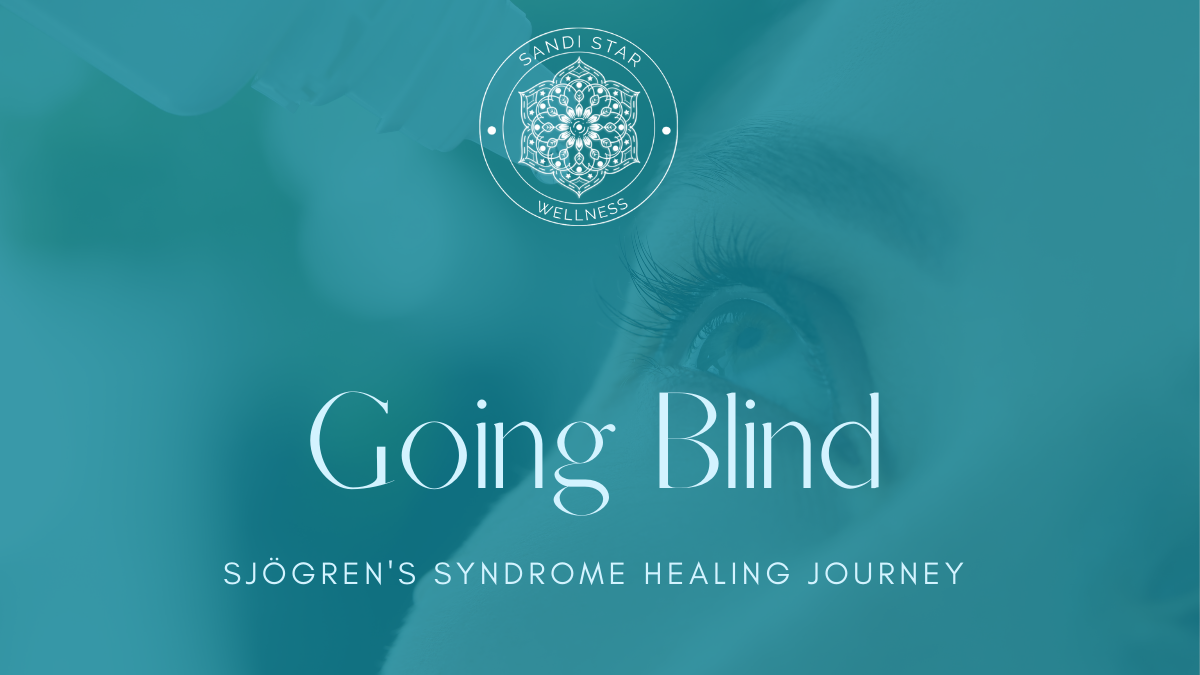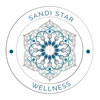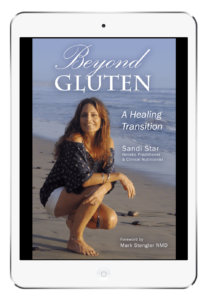
20 Apr Going Blind by Sandi Star
I remember using a ton of eye drops and never getting any relief. I was finding pieces of Sclera (the white, dense, fibrous outer coating of the eyeball) inside the lids and I was getting scarring. I was working full time and going to school at night; looking at a computer screen all day and books all night made it much worse! The lights at night were a big blur and I couldn’t focus on all. My eyes were literally drying up. I was having ongoing eye infections. To say the least I was going blind and was petrified. I couldn’t wear contacts to save my life. They would pop right out or worse, get caught in the corner of my eye.
I saw an eye doctor who never had any answers. He never thought to test me for Sjögren’s Syndrome. They put silicone plugs in my tear ducts to try and keep what little moisture I had in my eyes. Talk about a scary situation! My general doctor who was determined to find out what was going on because it went way beyond the eyes. I was extremely fatigued and had major joint and muscle pain, stomach issues, brain fog and upper respiratory infections often. I was discouraged but felt lucky my doctor cared who by the way told me it wasn’t in my head (nice rarity). I knew eventually we would figure it out. He ran some blood work and found I had Sjögren’s Syndrome and sent me to a Rheumatologists. I was about to add more medication to my already long list at the time and decided to look into a holistic approach. Since going gluten and cow dairy free, I have been able to wear contacts daily and most of the symptoms from Sjögren’s are gone. I consider myself one of the lucky ones who took control and can manage a great deal with nutrition alone. In fact, the antibody does not show up on labs these days.
Interestingly, up to 15% of people diagnosed with Sjögren’s syndrome also have celiac disease confirmed with a biopsy, making it far more common in Sjögren’s patients than it is in the general population. [1]
It’s not clear exactly why celiac and Sjögren’s occur together frequently however, it is common to have more than one autoimmune disorder.
It may be that there’s a common trigger—possibly gluten, but that’s not proven. I will say, I see the connection in my patients because of the damage gluten does in the GI (gastrointestinal) tract.
What is Sjögren’s
Sjögren’s syndrome is a chronic autoimmune disease in which people’s white blood cells attack their moisture-producing glands. Today, as many as four million Americans are living with this disease. Although the typical symptoms are dry eyes and dry mouth, Sjögren’s may also cause dysfunction of other organs such as the kidneys, gastrointestinal system, blood vessels, lungs, liver, pancreas, and the central nervous system. Fatigue is quite common as well as joint pain. Those with Sjögren’s have a higher risk of developing lymphoma.
Sjögren’s affects about 4 million people in America. Nine out of 10 patients are women. About half of the time Sjögren’s syndrome occurs alone, and the other half it occurs in the presence of another autoimmune connective tissue disease such as rheumatoid arthritis, lupus, or scleroderma. When Sjögren’s occurs alone, it is referred to as “Primary Sjögren’s.” When it occurs with another connective tissue disease, it is referred to as “Secondary Sjögren’s.”
All instances of Sjögren’s are systemic meaning it affects the entire body and can vary from person to person with symptoms including their severity. Some are lucky enough like me to be in remission. Since symptoms of Sjögren’s syndrome mimic other conditions and diseases, Sjögren’s can often be overlooked or misdiagnosed. Just like Celiac, it takes nearly seven years to receive a diagnosis of Sjögren’s syndrome.
Testing
There is no single test that will confirm diagnosis. Rheumatologists’ responsibility for diagnosing and managing Sjögren’s syndrome is to conduct a series of tests and ask about symptoms such as dryness, changes in salivary (mouth) and lacrimal (eye) gland function, and systemic (whole body) findings. [2]
Blood tests your physician may perform include:
ANA (Anti-Nuclear Antibody)
ANAs are a group of antibodies that react against normal components of a cell nucleus. About 70% of Sjögren’s patients have a positive ANA test result.
RF (Rheumatoid Factor)
This antibody test is indicative of a most often performed for the diagnosis of rheumatoid arthritis (RA) but is positive in many rheumatic diseases. In Sjögren’s patients, 60-70% have a positive RF.
SS-A (or Ro) and SS-B (or La)
These are the marker antibodies for Sjögren’s. Seventy percent of Sjögren’s patients are positive for SS-A and 40% are positive for SS-B (these may also be found in lupus patients).
ESR (Erythrocyte Sedimentation Rate)
This tests measures inflammation. An elevated ESR indicates the presence of an inflammatory disorder, including Sjögren’s syndrome.
IGs (Immunoglobulin’s)
These are normal blood proteins that take part in immune reactions and are usually elevated in Sjögren’s patients.
The ophthalmologic (eye) tests include:
Schirmer Test
Measures tear production.
Rose Bengal and Lissamine Green
Eye drops having dyes that an eye care specialist uses to examine the surface of the eye for dry spots.
The dental tests include:
Salivary Flow
Measures the amount of saliva produced over a certain period.
Salivary scintigraphy
A nuclear medicine test that measures salivary gland function.
Salivary gland biopsy (usually in the lower lip)
Confirms inflammatory cell (lymphocytic) infiltration of the minor salivary glands.
Your physician will consider the results of these tests along with your physical examination to arrive at a final diagnosis. Further research is being conducted to refine the diagnostic criteria for Sjögren’s syndrome and to help make diagnosis easier and more accurate.
Treatments
The treatment of patients with Sjogren’s syndrome is focused on areas of the body that are involved and complications that arise such as infection. There is no cure for Sjogren’s syndrome however, based on my holistic experience it can be managed. It’s important to monitor the antibodies and inflammation markers and pay attention to symptoms. I have managed to eliminate the symptoms related to Sjögren’s without any medications. This is the ideal situation in controlling any autoimmune disorder.
Dryness of the eyes can be helped by artificial tears, eye-lubricant ointments at night, and minimizing the use of hair dryers. Dry environments can also contribute to symptoms. When dryness becomes more significant, the ophthalmologist can plug the tear duct closed so that tears cover the eye longer. Cyclosporine eye drops (Restasis) can reduce the inflammation of the tear glands improving their function however, it can be painful to use and have side effects like all medications. Signs of eye infection (conjunctivitis), such as pus or excessive redness or pain, should be evaluated by the doctor.
The dry mouth can be helped by drinking plenty of fluids (half your body weight in ounces of water is recommended), humidifying air, and good dental care to avoid dental decay. Avoid mouth wash with alcohol as it is drying. Many types of agents are available as over-the-counter products, including toothpaste, gum, and mouthwash (Biotene). Vitamin E oil has been used with some success. Infections of the mouth and teeth should be addressed as early as possible to avoid more severe complications. Seeing a dentist every 6 month for cleaning is highly recommended. Diligent dental care is very important. Saltwater (saline) nasal sprays can help dryness in the passages of the nose. Vaginal lubricant should be considered for sexual intercourse.
As mentioned, each person is different in how they are affected by Sjögren’s. Because I know firsthand, I would say first and foremost – STAY OFF GLUTEN. Diet is crucial. Knowing your food intolerances can make a significant different. As I mentioned earlier, cow dairy was also an issue for me and caused inflammation because of my intolerance. In fact, 50% of Celica’s are intolerant to the cow dairy protein (not to be confused with lactose).
Once you have that under control you can talk to your doctors about complimentary treatments if needed. The biggest thing with any auto immune disease is inflammation. Make that your number one goal to have that under control. Consider a holistic approach which has no side effects and is a lot safer long term. Here are some more useful tips.
Some essential tips for Sjögren’s
- Avoid stomach upset. Remember the GI is connected systemically.
- Never feel guilty about seeking a second opinion.
- Join a support group if needed.
- Listen to your body. Do not take on more than you can handle, and pay attention to new symptoms, or symptoms that get worse, and tell your practitioner.
- Do your research.
- Make sure you coordinate all your care in Sjögren’s and head your “medical care team.” You want to make sure you are keeping records on medications, supplements and herbs. Make sure your physician knows about all the prescription and OTC medications you are taking. Many drugs have side effects that can make your Sjögren’s symptoms worse.
- Become an active participant in your treatment decisions and be informed. You will feel more in control of your wellness, decrease anxiety, and ensure you are getting the best possible medical care for you.
- You can maintain a good quality of life with Sjögren’s. Stay on top of the latest information, educate yourself, find support and watch your limits.
- Keep positive relationships and support in your life. These will help you cope and will reduce general anxiety when you have an often-misunderstood disease.
Dry Mouth Survival Tips
- Eat soft, moist foods if you have trouble swallowing. Sip small amounts of warm water with a meal.
- Eat smaller, more frequent meals to stimulate saliva flow.
- Eat smaller bites as the esophagus can be dry and swollen in which food can get stuck.
- Chew sugar-free gum or suck on hard xylitol sweetened candies to help increase saliva. The best gum I’ve found is xylitol sweetened. There are a few brands now to try and they also make mints.
- Apply vitamin E oil or moisturizing gels to dry or sore parts of the mouth or tongue for long-lasting relief. Use the liquid oil or punch holes in vitamin capsules to apply.
- Try using a probiotic for oral health.
Dry Eye Survival Tips
- Try sterile eyelid cleansers or a mild shampoo on a warm washcloth or Q-Tip to help with blepharitis, a common condition in Sjögren’s that causes chronic inflammation of the eyelids and eyelid margins.
- For dry eye, apply a warm, wet compress to the closed eyes using a washcloth. Apply at bedtime and upon awakening for 5 minutes, or more often if helpful.
- If your eyes are bothered by light, wear sunglasses with UV protection that cover a large portion of your eyes including the sides.
- Avoid applying anything to the eyelids that can irritate your dry eye; products placed on the eyelid will get into the tear film. This includes eye liner on the inside of the eye lid.
- If you wear makeup including mascara, make sure it’s nontoxic and nondrying to your eyes.
- Try eye ointments or gels at bedtime by first applying them only to the eyelids and lashes. If that is not helpful, place ~1/4 inch of ointment between the lower lid and eyeball.
- Eye ointments and gels can blur your vision and are usually reserved for overnight use.
- If your vision is blurred with artificial tear use, try a less thick (viscous) drop or ointment during the day.
Dry Skin Survival Tips
- Take short, warm baths or showers to help with dry skin. Hot water removes skin oils.
- Pat dry after bathing and moisturize at once while the skin is still damp. Natural oils such as coconut, almond, sesame and apricot work well.
- Avoid synthetic (perfume) fabric softeners in the washer and dryer. Always use hypoallergenic products.
- After swimming, make sure that you shower and at once use a moisturizer to reduce dry skin symptoms. Chlorine can be an irritant.
Sun & Sjögren’s Survival Tips
- To reduce reactions to the sun, wear good UV-protective eye lenses and sunglasses, and seek the shade when outside.
- Protect your skin and eyes through use of sunscreen, sunglasses, ultraviolet light-protective clothing, hats, and non-fluorescent lighting. UV radiation from the sun and other light sources can cause skin rashes, flare ups and sensitivity.
- Consider buying UV-protective car and home window films that are clear or tinted to protect yourself from UV radiation.
- Look for the words “broad spectrum” on sunscreen protection. This means that you will be protected from both UVA and UVB radiation. Look for one that is nontoxic and has no fragrance.
- Make sure you are taking enough Vitamin D3 and antioxidants for your immune system. Best to get your levels tested annually. Most people are deficient in Vitamin D.
Fatigue Survival Tips
- Know your limits and pace yourself if you have fatigue. It’s ok to rest.
- A common cause of chronic pain and fatigue in any disorder, including Sjögren’s syndrome, is lack of exercise. Movement is important.
- Educate your friends and family about what you are going through and how fatigue in Sjögren’s syndrome can come and go. Remember everyone has different symptoms.
- Although Sjögren’s can cause fatigue, there can be other related causes such as adrenal fatigue or hypothyroid disease and depression so make sure you are working with a practitioner for guidance.
Brain Fog Survival Tips
- Brain fog is a major complaint of Sjögren’s patients so make sure you keep the brain engaged. Brain fog can also be a symptom of leaky gut, food intolerance or side effects of drugs so make sure you are working with a practitioner for guidance.
- To help symptoms of “brain fog,” minimize stress and anxiety. Take breaks throughout the day and learn relaxation exercises and practice them at regular intervals.
- Reduce caffeine and alcohol to help with “brain fog” and sleep problems in Sjögren’s.
Dry Nose & Ear Survival Tips
- Use natural saline spray several times a day if needed. Clean and moisture nasal cavity in the morning and again at night. This helps keep allergens from settling in the cavity as well.
- A drop of earwax remover or mineral oil can help dry itching ears.
Herbal Remedies and Supplements
Rosemary
The rosemary plant has several anti-inflammatory agents that help in the prevention of arthritic pain and dryness caused by Sjogren’s Syndrome. It is recommended to make rosemary tea instead of eating the plant. Mix a half an ounce of rosemary leaves in a pot of boiling water. Cover the pot and let the mixture simmer for 30 minutes. Consume the tea before going to bed. This can be repeated as often as necessary.
Evening Primrose Oil
Evening primrose oil has gamma linolenic acid, also known as GLA. GLA is a fatty acid that helps Sjogren’s Syndrome sufferers by introducing prostaglandin into the system. Prostaglandin in turn works as an anti-inflammatory to help common Sjogren’s Syndrome symptoms. Evening primrose oil should be taken daily, with a dosage of 3,000- to 6,000-mg.
Celery Seeds
Celery has several different anti-inflammatory agents that can help Sjogren’s Syndrome symptoms such as joint paint, inflammation, and lethargy. Celery also packs over 340 milligrams of potassium per single cup. This is beneficial to anyone with an autoimmune disease since lack of potassium can cause arthritic like symptoms. Celery plants can be eaten in large quantities, but for faster and easier results, celery seeds are recommended. Place a teaspoon of celery in a cup of boiling water. Up to three cups daily may be consumed.
Gamma-linolenic acid (GLA) may reduce inflammation. Much of the GLA taken as a supplement is converted to a substance called DGLA that fights inflammation. Having enough of certain nutrients in the body (including magnesium, zinc, and vitamins C, B3, and B6) helps promote the conversion of GLA to DGLA.
Cysteine is an amino acid that can be found in many proteins throughout the body. When used as a supplement, it is usually in the form of N-acetyl-L-cysteine (NAC). The body converts this to cysteine and then to glutathione, a powerful antioxidant reducing symptoms associated with Sjögren’s syndrome.
Remember, take care of yourself and eat a whole food allergy friendly diet to help address inflammation. Limit your sugar intake and try to stay away from processed and fast foods. These are damaging to the GI tract. If you have Celiac get tested for Sjögren’s if you are experiencing any of the symptoms.
REFERENCES:
Koopman, William, et al., eds. Clinical Primer of Rheumatology. Philadelphia: Lippincott Williams & Wilkins, 2003.
Kelley’s Textbook of Rheumatology, W B Saunders Co, edited by Shaun Ruddy, et al., 2000.
Sjögren’s Foundation.
© Copyright 2017
This is intended for informational and educational purposes only and is not intended or suited to be a replacement or substitute for professional medical treatment or for professional medical advice compared to a specific medical question or condition. Results vary from person to person and cannot be guaranteed.


